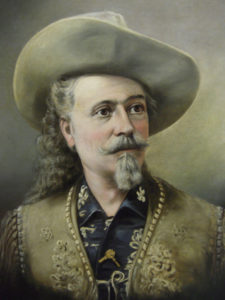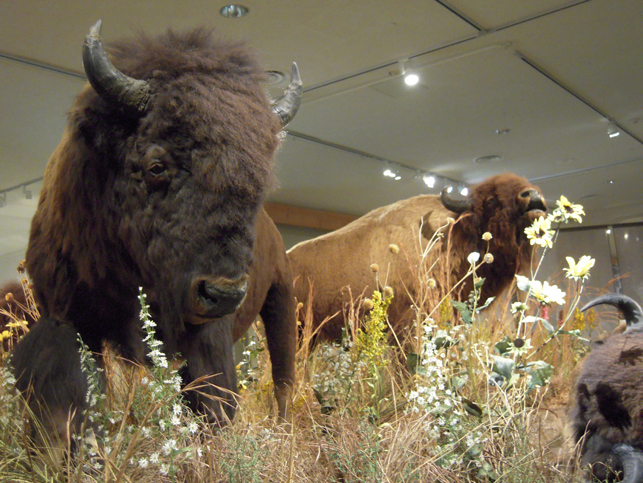
William F. Cody earned the nickname Buffalo Bill after shooting 68 buffalo over the course of one eight-hour day. Photo by David DeVoss
By David DeVoss
Cody often is described as “the most historic and charming town in Wyoming” and an “American town that still feels like the Wild West.” There’s plenty to do in Cody and while you’re doing it you can listen to a free TravelStories walking tour tape that provides a 45-minute background on the area’s early settlers, which include the town’s namesake, Col. William F. “Buffalo Bill” Cody, the West’s greatest showman.
I grew up wearing a cowboy hat, rode a stick horse, strapped on chrome-plated cap pistols when I went out to play and faithfully watched Roy Rogers every Saturday. I knew I wasn’t a Yankee. Still, I was uncertain whether being raised in Dallas meant I was Western. Ft. Worth folks claimed their city was “Where the West Begins.” My hometown, they smirked, was “where the East peters out.”
At college, I met students from West Texas who wore boots and jean jackets and knew a lot about cattle brands and barbed wire. They all had that resigned air of ranchers whose lives depend on rainfall, insecticide and commodity prices. But years invested in Roy, Maverick, Sky King and the Rifleman left me confident I probably had the stuff to survive on the Big Lonesome beyond the Rockies.
But where is the West, really? Los Angeles is west but sheriff deputies here don’t ride horses. Oregon has the Pendleton Rodeo but the state is better known for craft beer and Portland’s lack of governance. Nevada has wide-open spaces but, come on, the state is wedded to gambling and UFOs. As for New Mexico, do people there care about anything except chili?
To find the real West I drove north up the old Goodnight-Loving cattle trail (aka US 25) to Cheyenne, WY and headed west across the state to Jackson. Nestled at the foot of the Grand Teton Mountains, Jackson Hole is not the West, despite the prolific use of antlers festooning many of its buildings. It survives because of winter skiing and the fact it is the gateway to Yellowstone National Park.
Yellowstone is a sanitized version of the West’s natural grandeur. It has bison, bears, glacial lakes and Old Faithful. Stay away from the bison and don’t take selfies with the bears and you’ll enjoy a culture that once covered most of western North America. But the real West I soon discovered lies east of Yellowstone in towns like Cody, Sheridan and Buffalo that are surrounded by silent Indian War battlefields.
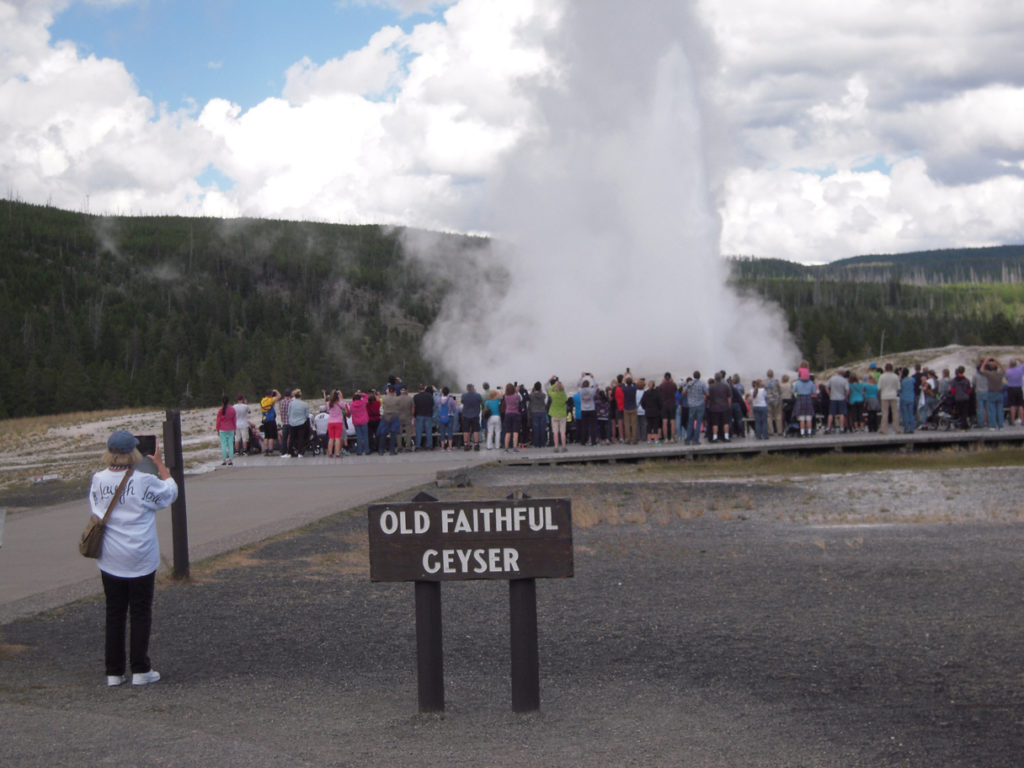
Geysers like Old Faithful make Yellowstone unique among national parks. The natural beauty surrounding the geysers is breathtaking, but little in the park is evocative of the West’s colorful past. Photo by David DeVoss
Named after legendary showman William F. “Buffalo Bill” Cody, Cody (pop. 10,000) venerates its past in ways that will appeal to every type of traveler and the Buffalo Bill Center of the West should be your first stop. It is full of Western art, antique guns and Wild West Show posters, but what kept me there for most of the afternoon were the artifacts of Cody’s life.
The former buffalo hunter (who got his nickname after killing 68 buffalo over the course of eight hours) became a national celebrity because of imaginative dime novels and then jumped to global stardom with Wild West tent shows that Mark Twain described as a “distinctly American pop-culture export to the world.”
Cody made several fortunes over his 71 years, which he promptly lost because of extravagant living. He also lost the love of his estranged wife Louisa, who sold his corpse to the Denver Post newspaper for $10,000. The Buffalo Bill Museum and Grave in Golden, CO claims to be his final resting place. Cody, WY. disagrees. It insists his body was stolen from a Colorado mortuary and returned to Cody where he wanted to be buried. As I spent more time in the real West I soon learned that some disagreements are best left unsettled.
About a mile from the Buffalo Bill Center is Old Trail Town, an open-air assemblage of old West buildings supplemented by some of the graves of men who drank and died there. If the Buffalo Bill Center conveys the personality of a man, Old Trail Town captures the haunting look and feel of the late 19th century Wyoming Territory. Those with imaginations, beware. Old Trail Town is a bit spooky even in the afternoon of a sunny day.
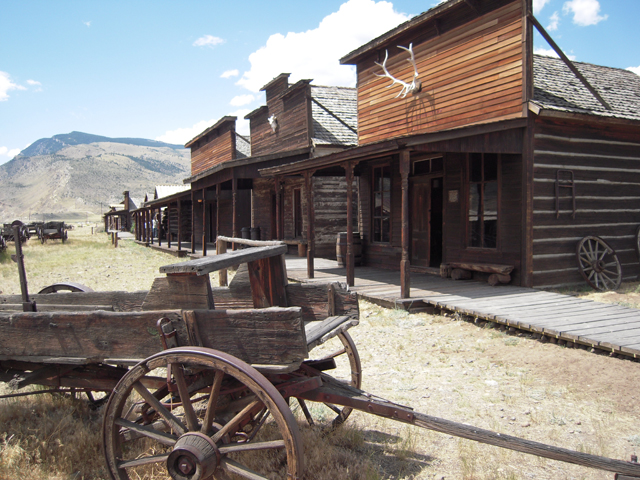
Old Trail Town preserves the history of the frontier West through a rare collection of authentic structures and furnishings moved from other parts of Wyoming and Montana and reassembled on the original townsite selected by Buffalo Bill. Ever the showman, Cody envisioned his eponymous settlement as a tourism-based frontier town where visitors might shuttle between the majesty of Yellowstone and the urban diversions he would create just east of the park. Photo by David DeVoss
Three of the buildings were used by the Hole in the Wall gang. The Rivers Saloon was where Butch Cassidy plotted two different bank robberies. The Mud Spring Cabin nearby was used by Kid Curry and the Sundance Kid as a hideout prior to their attempted 1897 robbery of the Red Lodge Bank. On the edge of town hard by the Mud Spring Cabin is the grave of trapper Jeremiah “Liver Eating” Johnson. When Johnson’s grave was moved to Old Trail Town in 1974, the celebrated mountain man was given a funeral attended by 2,000 people. It remains one of the largest burial services in the history of Wyoming.
Cody’s Western spirit thrives outside museums. Witness the Cody Nite Rodeo, the longest-running (84 Years) nightly outdoor rodeo in the world that is scheduled to start June 15. Nightly events include steer wresting, bull riding and bronc riding, but for me the most authentic event was the calf scramble where several dozen young children try to rope, drag to the ground and tie down an equal number of young calves. It’s an opportunity for young kids to get dirty, attempt to capture animals far more nimble than they and refine rodeo skills displayed earlier in the evening by professional cowboys and women. It was safe, wholesome and family-oriented. I loved it, as would any kid in America.
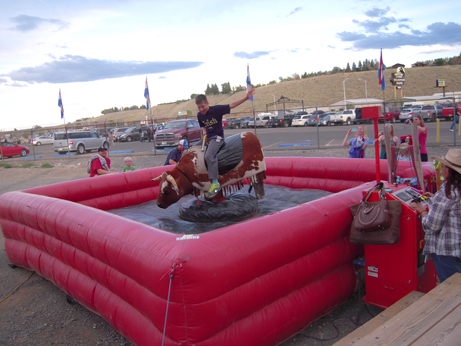
Cowboys of all ages can hone their skills at the 84-year-old Cody Nite Rodeo, which is open every night during summer months. Photo by David DeVoss
Cody is surrounded by hot springs and hiking opportunities, but after an evening at the Nite Rodeo I drank Wyoming Whiskey at a Sheridan Avenue bar and decided to sleep late. I arose with the knowledge that though I was no match for kids in the calf scramble, at least I was becoming less of a city dude. My destination for the second day in town was the Irma Hotel, a 1902 hotel built by Buffalo Bill who named the place after his daughter. Frederick Remington, Annie Oakley and Calamity Jane all stayed there, each of them probably downing a whisky or two at its famous cherry wood bar, a gift from Queen Victoria.
A block from the Irma, however, I stumbled upon the Dug Up Gun Museum, a free (donations appreciated) exhibition filled with discolored, muddy and rusted firearms, each of which came with an explanation of its provenance and likely use. The museum also has antique guns for sale, but the Spirit of the West didn’t move me enough to buy one.
The Irma Hotel is a must-see attraction. With an advance reservation, it’s possible to stay in Buffalo Bills’ private suite. This I did not have, but since it was summer I was able to see the historical play the Irma presents on a side street next to the hotel. Costumed locals portray Buffalo Bill, Calamity Jane, a U.S. Marshall, two Hole in the Wall outlaws, a bar girl and a bartender. The plot is unimportant and nobody takes themselves too seriously. The actors hang out afterward and dispense stories and selfies with a smile.
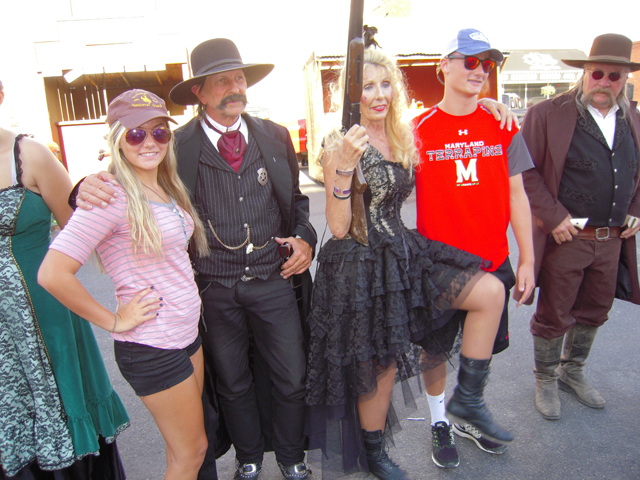
Actors appear nightly outside the Irma Hotel in downtown Cody. Buy a drink, take some photos and learn local lore not always found in the guidebooks. Photo by David DeVoss
After several cocktails and the show at the Irma, I headed across Sheridan Avenue and down the block to the Cody Theater, which houses Dan Miller’s Cowboy Music Review.
OK, I know what you’re thinking. No amount of Old West romance makes country music palatable. But Dan Miller and his fiddle-playing daughter Hannah are not cornpone banjo pluckers of the sort you hear in Branson or Nashville. Both are accomplished musicians who artfully demonstrate that Western music is different from country music.
When I left Wyoming I still did not feel like a real cowboy. I have no desire to hunt or put antlers above my front door. But as an American, I now have an affinity for the West, a deeper appreciation of its history and an abiding desire to return and linger among the people of Wyoming, who are really easy to like.![]()
_______________________
David DeVoss is a senior correspondent with the East-West News Service


